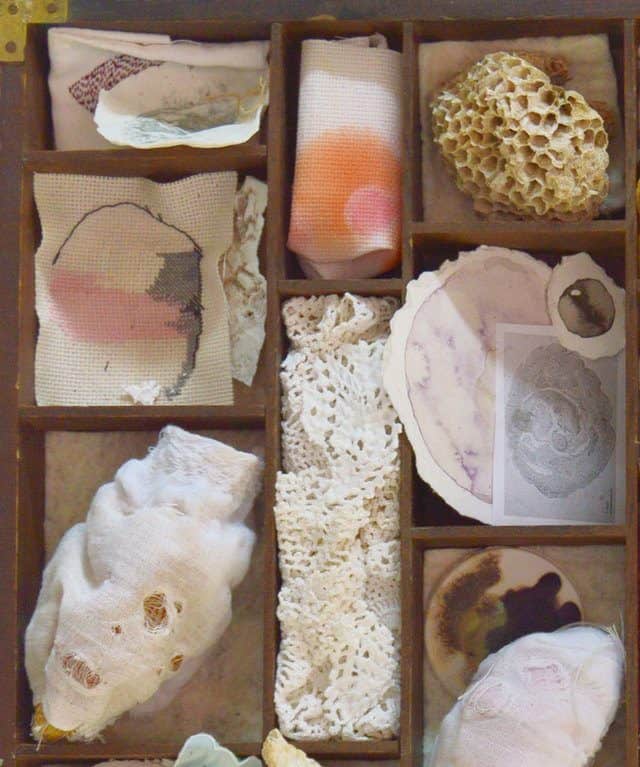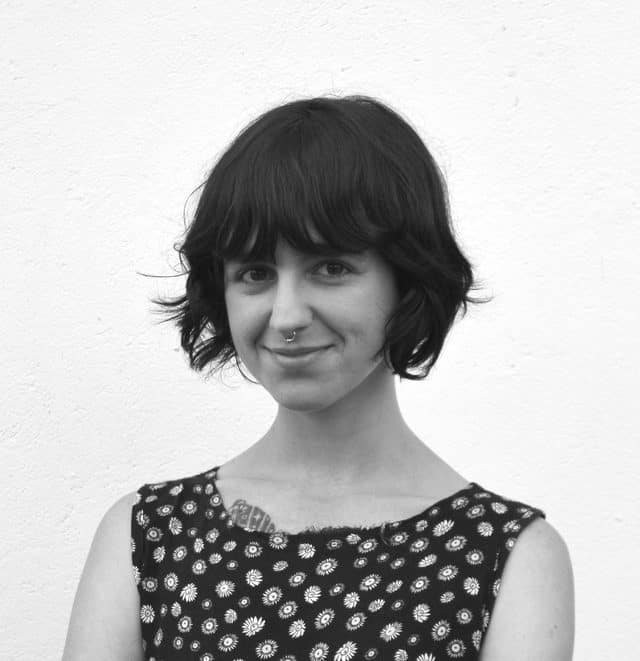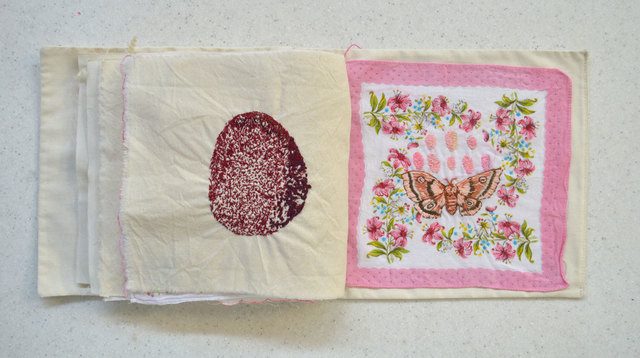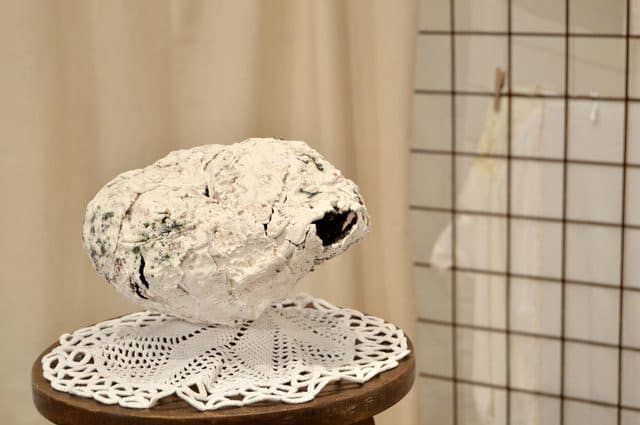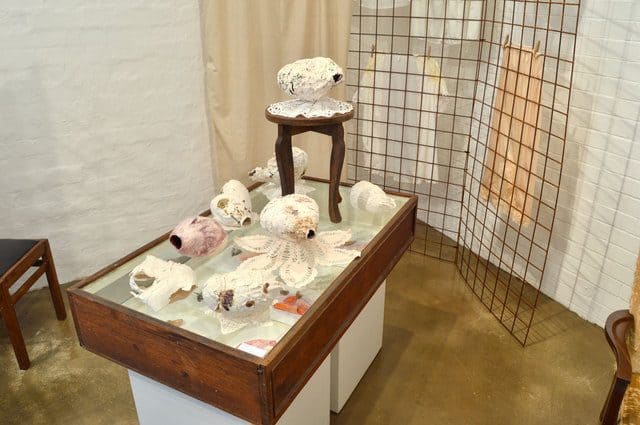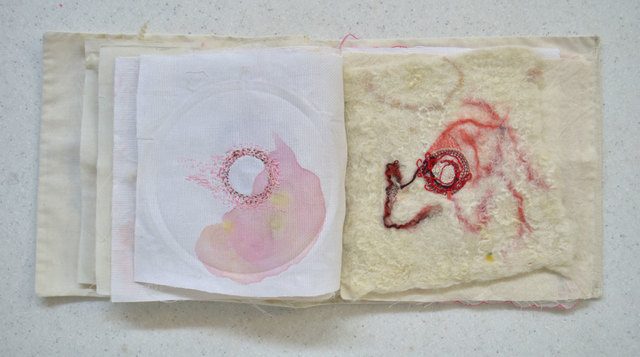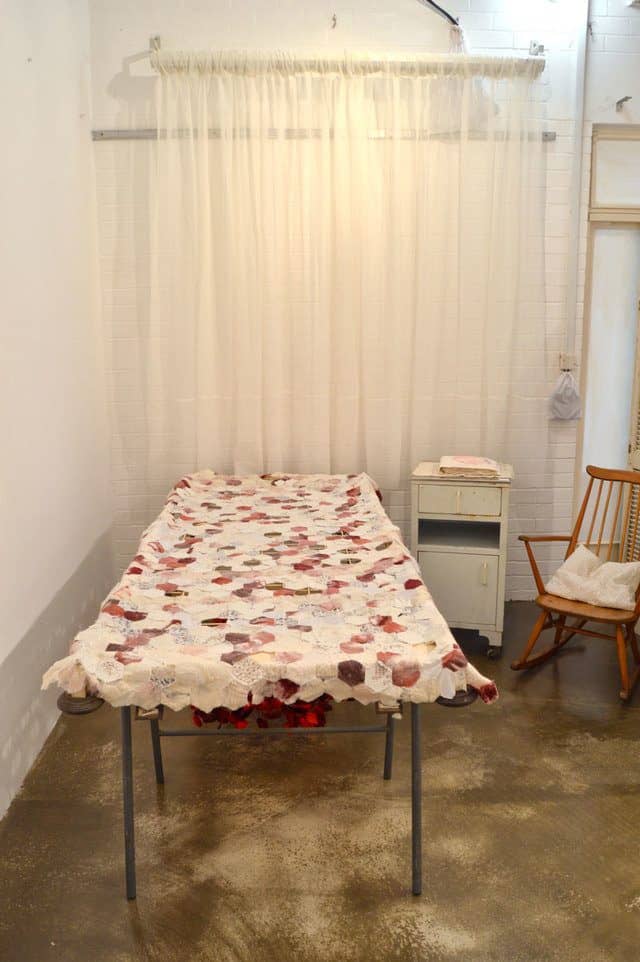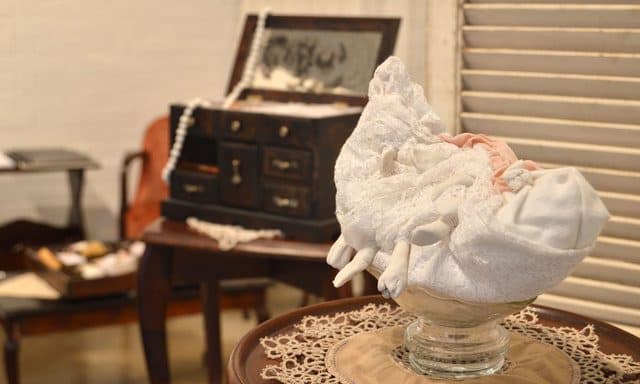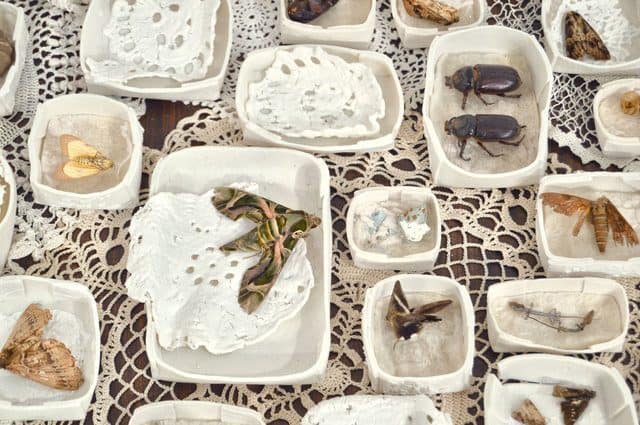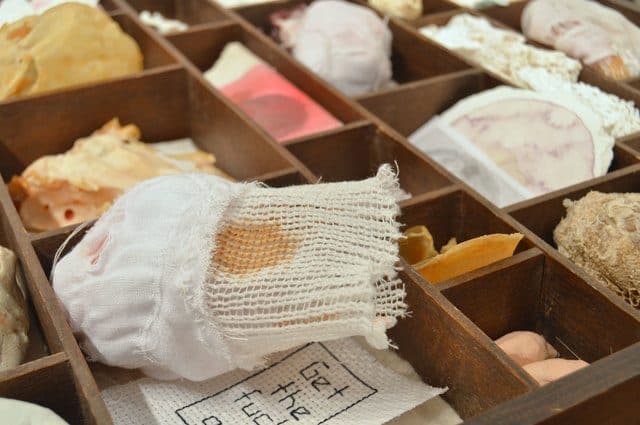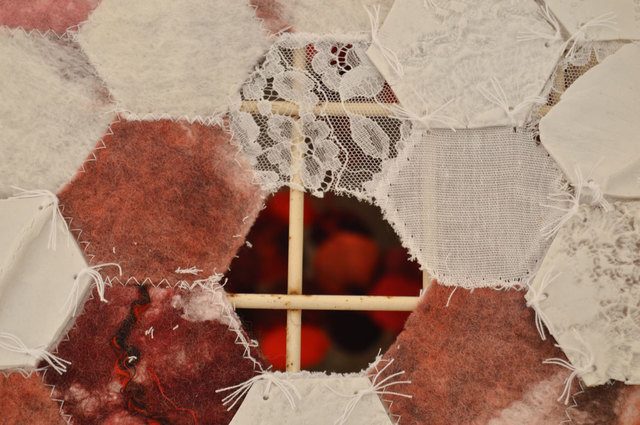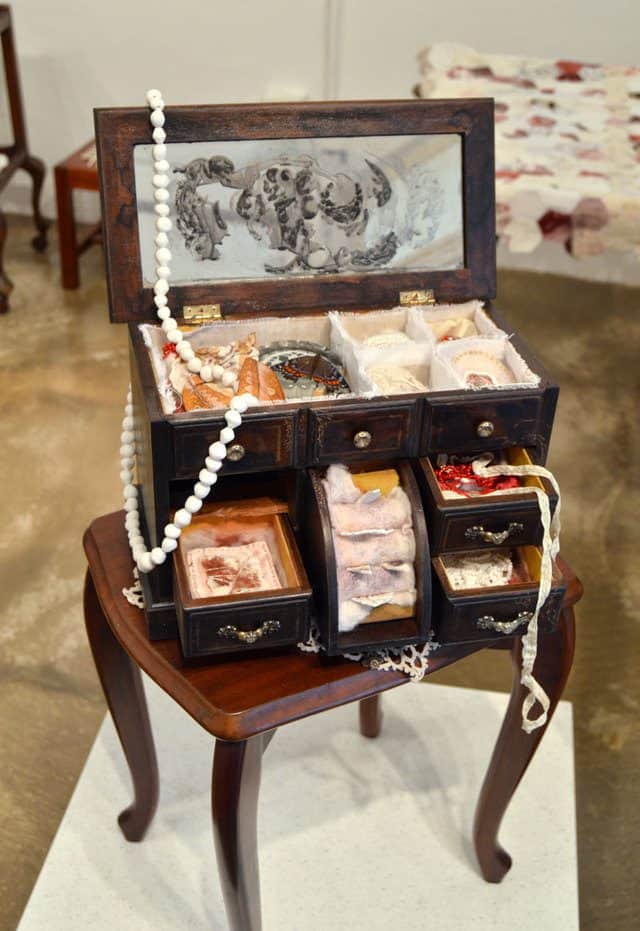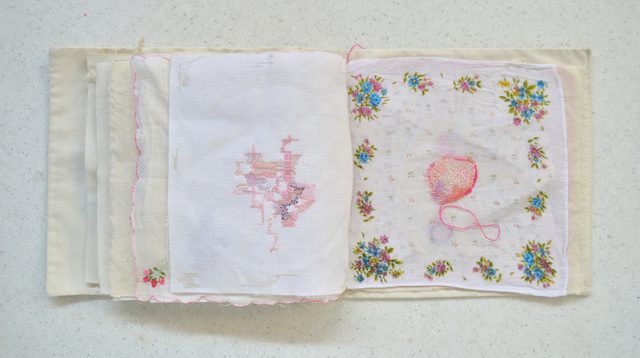Typically this blog focuses only on crochet but occasionally there is an artist working in another area of fiber arts that has so much talent that I just have to share. That’s the case with South African artist Jessica Merle, a multidisciplinary artist working in embroidery, ceramics and other media. Much of what she shares in this interview will resonate with readers who have turned to crafting to get through a tough time, foster a sense of connection with previous generations and express themselves creatively. She also discusses how working in a traditionally gendered craft (whether that’s embroidery or crochet) becomes performative, offering opportunities for social commentary, personal growth and community healing. Her work touches on important themes of trauma but what she offers is a place not only for discussion but also for inspiring hope and recovery. The photos shown throughout this post are the body of work Jessica created for her Masters research and final exhibition. Keep up with her work on Facebook and Instagram.
When and how did you learn to embroider?
I first experimented with embroidery when I was about eight years old. My mom has always sewn, and I would use small off-cuts of fabric and her sewing thread to create little sampler-like pieces. I later learned to do cross-stitch; in 2003 my family moved to the UK and we discovered Hobbycraft! My mom bought some cross-stitch kits, loads of embroidery thread and Aida cloth and made cross-stitched Christmas cards for our family in South Africa. Soon my younger sister and I joined in, first by referencing patterns in magazines and then soon we were creating our own small cross-stitch patterns.
And did you stick with embroidery from then on?
Once we moved back to South Africa the cross-stitch was somewhat abandoned for a time. It was about ten years later that I resumed the craft. I started my Masters degree in 2014, but I was struggling to produce the work I thought was expected of me while also trying to move on from a really bad relationship. I had a yearning to try to create with embroidery again (although in retrospect I think what I most wanted was to return to a childhood comfort), so I hauled out our old thread and Aida and built on what I remembered by using embroidery ‘how-to’ books. Since then I’ve just been perfecting my craft and improving my skills.
Why is embroidery your chosen medium?
For me using embroidery as a medium is a very personal choice. I feel connected to my mom, my grandmothers and great-grandmother when I embroider.
Embroidery also allows me to express my concepts and themes in a very specific way. The process of embroidery is very time-intensive, repetitive and constrained and in a sense quite cathartic. I explore ideas of catharsis and healing in my work, and embroidery allows me to perform these themes as I make, through the cyclic application of suturing stitches. I’ve realized as I answer this question that embroidery has become a medium of choice for me due to what it offers and allows me to do. It, and most other textile crafts, has always taken care of me.
How does this compare to other mediums you work in?
The other media I tend to lean towards working with include ceramics, watercolours and drawing. I majored in ceramics in my final undergraduate year and then specialized in it for my Honours. It was then in my Masters that I incorporated embroidery and fabric with porcelain. One of my research objectives was to find ways of combining such seemingly incongruous media and I battled somewhat to make that happen.
While ceramics requires its own specific set of skills and rules to ensure that your work survives each process I still feel more ‘physical’ freedom with it in a sense that I can work quickly and messily and see results sooner. It’s a lot more physical, which I enjoy. I treat my drawing and watercolours in a similar way; I work quickly with scratchy lines and muddied colours. It’s great to be able to switch between processes, having a fast messy week of work followed by a slow and introspective week of production.
What do you most hope people take away from seeing your work?
While my work deals with some heavy issues such as abuse and trauma, specific to the experiences of women but also relevant for men, it also brings in elements of the recovery and repair that follows these experiences. I most hope that viewers of my work are able to take home with them feelings of hope and optimism, a greater understanding of the realities of our world and maybe even a desire to bring about change. It is so encouraging and fulfilling when someone approaches me to say that seeing my work provoked an emotional response, a feeling that they are not alone in traumatic things they have been through. I just want to make connections with others by being brave enough to express topics that are otherwise considered taboo to be open about.
How does art help us work through trauma?
I think that whatever our intentions with our art there is always a personal slant to it. Art offers us a channel to think about our experiences and unpack them, to really think them through, analyse and then express them. It can be diaristic without being self-indulgent, and can assist an artist as a psychological process while also offering the same to viewers of the art. The making of art starts as a personal therapy through the making process, and then becomes a ‘group’ therapy when it is shared and the audience becomes part of the process. It starts important conversations and can act as a catalyst for confronting personal demons.
How do your chosen mediums help express your message?
The connections between my media and messages is something I have been grappling with for the past few years, and through my research I came to discover that not only do the media and their histories reflect on the conceptual content of the work but the specific processes I use do so as well. My work speaks about the experiences of women and my media, especially embroidery and porcelain, have contributed to this expression in so many ways!
Embroidery has come to be associated with women and femininity over the centuries and evolved in the Middle Ages as a hobby to keep women away from idleness. This was reinforced by the Victorians in the 19th century and women would display themselves as marriageable through their textile crafts. Today most women, and also men, employ their textile crafts for creative expression and business opportunities and it is no longer a symbol of gendered oppression. Still, it strongly represents womanhood and femininity, and I take advantage of that in my work. The process of embroidery then becomes performative, and through making embroidered works I feel that we ‘perform’ old ideas of being female- quiet, occupied, domesticated, able to stick to mind-numbing, repetitive tasks. At the same time in my own work the process reflects on concepts of metamorphosis, catharsis and healing. The repetition becomes the cathartic act, allowing introspection and the application of stitches is like suturing together wounds to bring about healing.
Ceramic production also has a gendered history. In ancient times the making of ceramics was divided between men and women, with men typically throwing at a wheel (once those had been developed) and women taking on the task of hand-building. Later, in British potteries male workers typically worked at the wheels and headed up all the other stages of manufacture. Female workers were considered unskilled and worked as assistants to the men, except in the stages of surface decoration where it was believed that women were best suited to delicate and sensitive ways of making. So in a similar way ceramics represents a society divided by gender. Additionally the material attributes of porcelain, namely translucency, purity, fragility and strength, add to my messages. As I build my sculptures they metamorphose, and they continue this metamorphic process through firing. Each one starts out fragile and undergoes several stages to return strengthened and glass-like.
What identity terms do you prefer? Can you tell us a little about your journey to claiming those identities?
Artist, craftsperson, feminist, woman… I am first and foremost an artist, or a craftsperson. I’m still at a crossroads with identifying who I am as a maker … Is my work art? Is it craft? What are my intentions with having this type of identifying label? I flit between these two constantly, but I do know for sure that from an incredibly young age I have always identified as a maker above all else.
My identities as a woman and feminist came about at the same time. I first paid close attention to gender when I was in my early teenage years in high school and there was this sudden bombardment of expectations to behave and ‘perform’ in certain ways. Guys became sexually aggressive, girls were slut-shaming each other, porn taught so many young boys the wrong things about sex. In my first relationships with boys I realized my position as ‘the girl’. I felt like I always had to compromise to keep them comfortable and happy, always say yes, never ‘nag’ and be a ball-and-chain. I hated it. At 16 I created a sculpture for an art project and did extensive research into feminism and feminist art and artists. It was the first time I had even heard about feminism and I felt a huge weight be removed from my shoulders as I discovered that I was not alone, that many other women felt this way and that we could and should do something about it. I immediately identified as a feminist, and have done so ever since.
To be honest, I’m not sure that I identify totally as a woman even though I am already 25, purely because I have not yet reached a point of total independence; I’m somewhere between being a girl and a woman. Perhaps when I have the type of stability I want, a small place to call home that I pay for myself, the ability to understand the world a bit more, and have established myself as an artist/craftsperson/maker I will see myself more as a woman.
And you are a South African girl / woman … How has being from South Africa influenced your work?
Women in South Africa have a pretty hard time, especially women of colour from lower socio-economic backgrounds. We sadly have an incredibly high rate of rape and domestic violence, and that’s only taken from incidents that are actually reported. At the same time there are problems of racism and economic exclusion. My own experiences as a woman, the experiences of women that I’m related to and know, as well as stories I hear in the news have resulted in gender issues being incredibly important to me and this influences my work. While I can only speak from the standpoint of a white, middle-class woman I attempt to look at our battles as a whole and discuss this through my work. I have to express these issues creatively.
On an aesthetic level I turn to Voortrekker embroidery and textile crafts for inspiration. It’s incredibly interesting how the decorative intersected with the functional in work created by women during the Great Trek and in white concentration camps during the Anglo-Boer War. For example, scraps of fabric from worn out clothing were used to piece together covers for the army-issue blankets to make them more comfortable. This craft was functional while also providing psychological benefits of comfort and reminding interred women and children of home. This idea of craft as useful and comfortable plays an important role in my work as I seek to express processes of healing and self-care after trauma.
What, if anything, do you most wish people around the world understood about South African women?
This is quite tricky to answer as women in South Africa come from so many different backgrounds and intersections, and so there are numerous layers to being a woman in this country. I’m not sure how South African women are perceived around the world. While white women have always had the advantage here, women of colour are slowly taking their positions in places of education, politics and power. This is so important. If I speak about what I know from my close group of friends from art school, we are hard-working, determined and aware of our realities. We want change and we are ready to bring about this change ourselves.
Transitioning more to subject matter … there is a repeating theme of moths in your work. What interests you about moths and what do they represent in your art?
Ironically I have a huge moth phobia! This fear became a strange combination of revulsion and desire to get closer to them. During a time of being trapped in an abusive relationship I kept myself busy and distracted by researching and reading up about moths, as a follow up to a recent sculptural project I had completed. I learnt so much, from basic facts about their behavior down to their physiology and the biochemical processes that take place during metamorphosis. While moths are still caterpillars they carry imaginal discs in different places on their bodies, and these are essentially the cells that develop into moth parts. During metamorphosis the caterpillar almost completely liquefies and the imaginal discs then divide and replicate to form the moth. Very little is known about this metamorphic process, it is so secretive and hidden. The little pupa is so vulnerable, it is neither a caterpillar nor a moth; but while it appears to be inactive in reality it is very busy and creating a whole new reality for itself. When the moth emerges from its cocoon it releases meconium, a liquid waste that is a by-product of metamorphosis, it contains all the old liquefied matter. I think it is the most incredible transformation ever. Moths began representing an escape for me, a reason to plug in and drop out of my reality. This evolved into the moth becoming a symbol of hope, rebirth, metamorphosis, escape, catharsis and release. They are a metaphor for self-care and the necessity to take care of oneself in order to survive. You already carry the potential with you.
How has your education in art influenced your work?
My art education has pushed my practice and me in ways I never imagined it would. The art school I went to is based in Pietermaritzburg in KwaZulu-Natal and it has a very traditional, craft background. I majored in ceramics in my third year and continued with it through Honours and into Masters, and all three of my lecturers were and are strong advocates for instilling strong craft skills in our work while also learning to break rules. I feel so privileged to have grown up as an artist with these authorities who have a respect for our craft histories and heritages and as a result I have learnt to appreciate the inherited skills I possess.
Through my education I have seen the self-consciousness of art and anxiety over what media can be considered art, and I think in a way it has led me to subvert these rules, to dangle my craft materials in a teasing way and attempt to blur such boundaries with both my ceramics and textiles. I have also learnt to question, analyse and criticize my work and myself constantly! Creative anxiety is not helpful, but it is important to have a healthy dose of criticism and questioning if we want our work to continue developing. It has helped me to realize that I cannot create in a vacuum and should not allow my work to become self-indulgent; I rather tend to treat my work as research processes now and my approach to creating is significantly different to when I fist embarked on my arts education.
What would you say to a young artist who isn’t sure whether or not to go to art school?
If art school is within the realm of financial possibility then I would absolutely recommend to any young artist to attend. Whether it is a full degree or a few night classes a week, I think that it is vital for young artists to get out there and learn as much as possible from practitioners who have experience. Just learn as much as possible, and constantly push yourself out of your comfort zone. Art school can be hell, and many people graduate feeling a bit disillusioned once faced with the light of day, but what can be learnt during this time is so invaluable. I would also suggest to young artists to find part-time jobs in the arts industry during their education time. This helps make some cash to pay for any materials but it also helps you to keep connected to the outside world and gain some arts-based working experience. Art school can become a bit of a comfortable cocoon and so it is important to emerge every now and then.
Have you enjoyed your own work in the art world – as a gallery assistant for example?
I have really loved and appreciated my work experience in the art world. As a gallery assistant I had the opportunity to see a bit of the behind-the-scenes of the art world and could learn how galleries operated. Through being on the other side of the relationship I have a much better understanding of what galleries expect and want from artists, how to approach galleries and maintain good relationships with them. That being said, my work experiences have also helped me to clarify for myself that how I really want to spend my life is making art … I’ll always want to be the artist.
How has your experience been so far with exhibiting your art?
So far I have really enjoyed all of my exhibiting experiences. I’m not yet in a position to pay for gallery space so I keep a close look out for any open calls for artists to submit work to be considered for exhibitions. The reception of my work has always been quite positive for a newcomer, and I just want to keep building on that and maintain connections with gallery owners and their assistants. I like to know that I’ve made a good impression on gallerists by being friendly, professional and reliable with any of my involvement in an exhibition.
What challenges have you faced as a female artist? Is your work received differently by men than women?
I don’t really feel that I have experienced any specific challenges in the art world due to my gender. I do sometimes get a vibe that the subject matter I work with, telling stories about female experiences and speaking out on taboo topics, and being associated with feminist art makes some people quite uncomfortable or even annoyed. I received some offhand comments from a colleague once that implied that my themes have already been exhausted, that men also experience hardships and so my points are exclusive and invalid.
Most women who view my work and speak to me about it seem to have very emotional responses. They feel and understand the pain and healing processes that my work expresses, almost as if they’ve been reminded of something they have already experienced. To be honest, I’m not sure at all if men view my work differently to women. I am quite fortunate to have fantastic male and female colleagues from art school who were all incredibly sensitive towards everyone’s work. I think perhaps that men might not always be able to relate to the work as closely as women are… it is definitely something for me to think about though.
What is your best advice for other young women in the arts today?
Take the time to find your voice and style; experiment with any and all the media you find yourself drawn to using; be brave and don’t be afraid to make work that you haven’t seen before or might not clearly fit into a particular genre; learn to not take criticism too personally; have integrity and be professional; keep fighting for what you want- most of the time you will have to push your way through the industry; make connections by being present at art events and learn to market yourself in person and online. Above all else, be true to yourself and your art and remember that if you take care of it, your art will take care of you too.
Paying it forward, who are some favorite female artists we should know about?
Senzeni Marasela is a favourite female artist of mine. Internationally known, she is Joburg-based and works with textiles and performance. Her alter ego is Theodorah, a rural married woman looking for her husband in Joburg. Senzeni uses clothing and embroidery to navigate the experiences of black women in South Africa.
Willemien de Villiers is a Cape Town-based artist who embroiders and paints. Her embroideries in particular focus on issues of abuse and domestic violence, and her intricately detailed textile pieces are just incredible.
Lady Skollie is another inspiring female artist from South Africa. Her colourful and playful drawings, often executed in wax crayon, cover topics such as gender, sexuality and race and their intersections in South Africa.
Other artists featured on Crochet Concupiscence who incorporate embroidery in their work include Andy of O&Y Studio, Blanka Amezkua, Emily Barletta and Leandro Dario,

